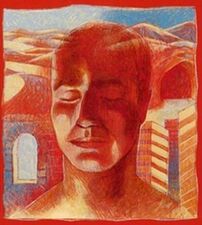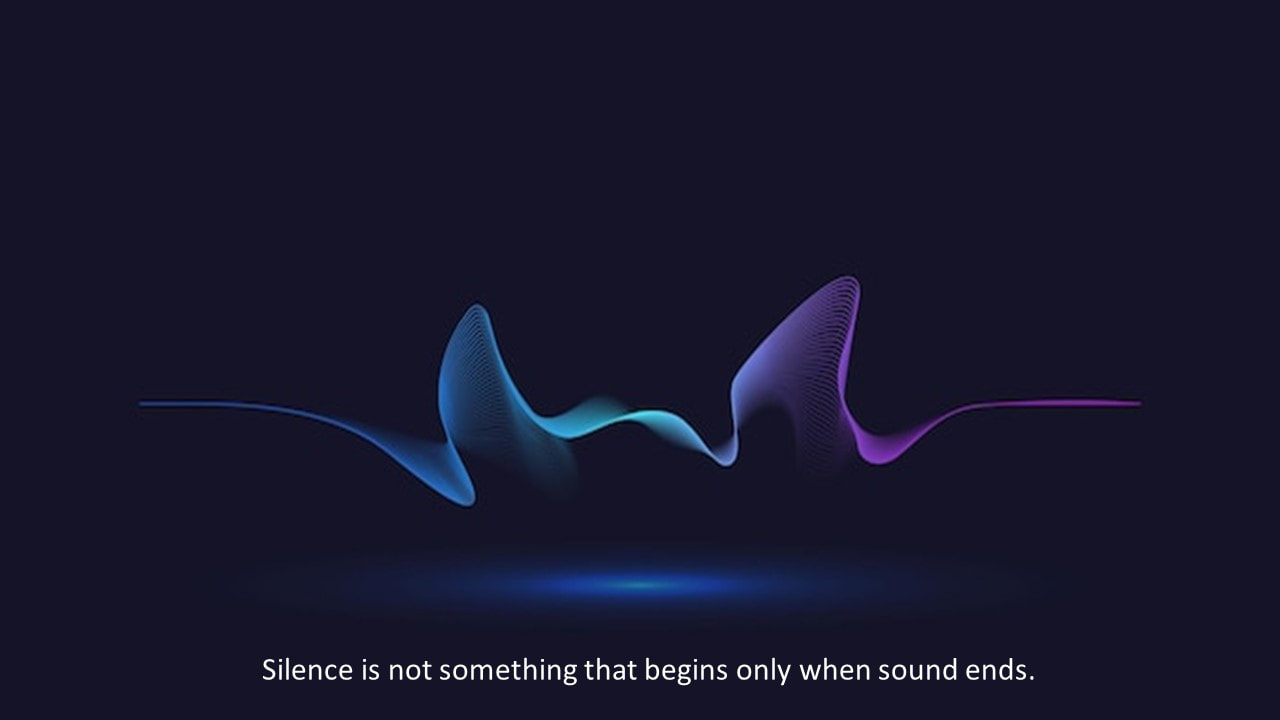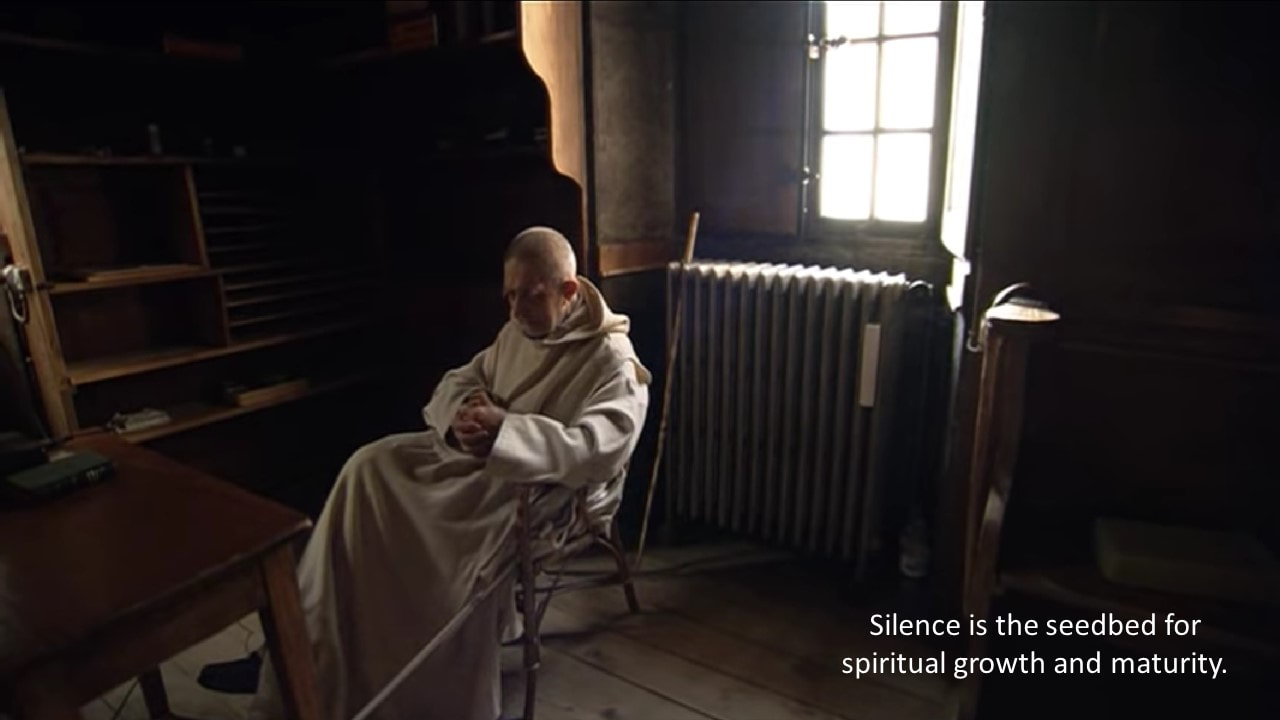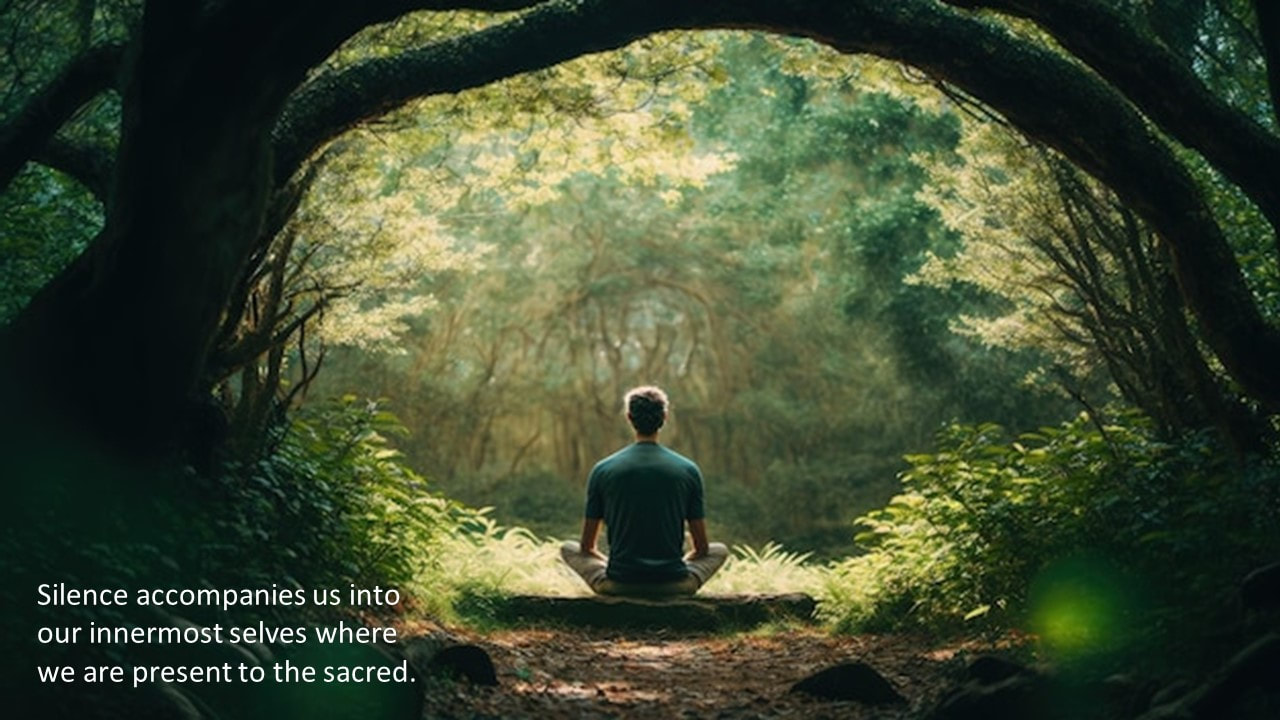The first week of each month has a short, image-backed quote with links to associated resources in the text below it. In other weeks, the short quote is taken from a longer one by the month's author, found below the image. The last week of the month has a short quote and questions to encourage reflection on all the month's quotations and images.
Peter-Damian Belisle, our author for June, is a monastic solitary and, like many, lives a hidden, contemplative life: there is no known photograph of him. Instead, the head and shoulders image above is taken from the front cover of the book by him from which this month's quotes will be drawn.
|
Guided Meditation for all quotes:
For a 5 minute audio guided meditation to use with each week's quote, click the play button on the image. To pause, and restart, click in the same place. To see the image full screen as you listen, click the expand screen icon in the corner. |
|
|
Lectio Divina with longer quotes:
For an audio guided Lectio Divina to use with this week's longer quote, click the play button on the image. Allow 10-15 minutes for this practice. To pause, and restart, click in the same place. For a text version of the Lectio Divina meditation, click the button. |
|
Monday 5th June, 2023
Peter-Damian Belisle, The Language of Silence: The Changing Face
of Monastic Solitude (Darton, Longman and Todd, 2003), 18.
Image: gar13 on Freepik.com
This short image-backed quote is from Peter-Damian Belisle's The Language of Silence: The Changing Face of Monastic Solitude (Darton, Longman and Todd, 2003), 18. You can read more about this book by clicking here.
Father Peter-Damian Belisle, OSB, Cam., was born in 1947. He has been a monk, then hermit-monk, for several decades and, like many who follow this path, his life is quite intentionally hidden. As a result, information about him is difficult to find. In the 1980s Fr Peter-Damian lived at Assumption Abbey, a Benedictine monastic community at Richardton, North Dakota in the USA. For a glimpse into the contemporary life of this community, see the brief video on their homepage, here. Whilst at Assumption, but under the name 'Augustin Belisle', our author for June wrote The Wheel of Becoming: Personal Growth through the Liturgical Year (St. Bede's Publications, 1987) - see here - and Into the Heart of God : Spiritual Reflections (St. Bede's Publications, 1989) - see here. You can read the first chapter of this book, 'Of Cathedrals and Cats', by clicking here.
Our book for this month, The Language of Silence: The Changing Face of Monastic Solitude, was written by Peter-Damian during his time at New Camaldoli Hermitage, a contemplative Benedictine community of Roman Catholic, monks. For a review of the book, see here. This community of Camaldolese brothers live in a remote location at Big Sur, a rugged and mountainous section of the Californian coast, more than 90 minutes from the nearest town. Camaldolese brothers remain predominantly in silence and reside in individual cells - hermitages - throughout the day, gathering together formally in the chapel for the daily round of offices and Mass. The Camaldolese tradition dates back to St Romuald at the end of the first millennium AD, and the monastic reforms he initiated and that continued through the 11th and 12th centuries. Peter-Damian quite probably took this new name whilst at Big Sur at the time of his profession as a hermit-monk in the Camaldloese tradition - in honor of the Peter-Damian, c.1007-c.1072, who wrote The Life of St Romuald (c.951-c.1027) and later became the Cardinal of Ostia, the sea port of Rome. You can find information about the New Cameldoli community here, and the website offers a description of the Camaldolese history, here. For those of you who enjoy short docu-films related to our authors, click here to go to a nine minute film about the community which includes helpful comments from some of the brothers about what it is to live from a place of inner silence and to listen with the ear of the heart.
During Fr Peter-Damian's time at New Camaldoli he also edited and contributed to a collected volume of essays on Camaldolese spirituality, The Privilege of Love: Camaldolese Benedictine Spirituality (Liturgical Press, 2002). He was the community's librarian and archivist, as well as being described as an artist, poet, sculptor and teacher on back covers of books published by him. He also translated into English significant texts on Camaldolese spirituality. Fr Peter-Damian no longer lives at the New Camaldoli Hermitage. No further information about his life has been available.
Monday 12th June, 2023
Peter-Damian Belisle, The Language of Silence: The Changing Face
of Monastic Solitude (Darton, Longman and Todd, 2003), 18.
of Monastic Solitude (Darton, Longman and Todd, 2003), 18.
Image: Keagan Henman, Ohio, USA, unsplash.com/@henmankk
This short image-backed quote is taken from the longer quotation, below, from Peter-Damian Belisle's The Language of Silence: The Changing Face of Monastic Solitude (Darton, Longman and Todd, 2003), 18-20. You can read more about this book by clicking here.
|
Listen to this week's longer quote:
To listen to the longer quote, below, being read, click the play button on the small version of the image next to or below this text. To see the image full screen as you listen, click the expand screen icon in the corner. |
|
'There is something awesome and breathtaking about real silence; it is numinous, pulling us out of our self-containment and calling us towards the invisible. Religious seekers "home in" on silence as homing pigeons return to their roost, because therein lies the language for personal communication with the sacred. … Silence is the origin of speech. … our silence within us liberates the word. It is an active part of speech, not simply the lack of sound within it. Silence helps us all to discover who we really are, and in so doing, participates in the sacramentality of personhood. …
We should not view speech in opposition to silence, as if words were inimical to the reality engendering them. Monastics have always tried, at least in theory, to curb the flow of words in order to emphasise the presence and power of silence. They do so out of respect for the power of the word – and the Word. Writing of the monastic spiritual leaders in nineteenth-century Russia who maintained their inner silence (hesychia) while communicating with visitors, Kallistos Ware describes how their words to each visitor were so powerful precisely because silence lay beneath them.
People are finding less silence in today’s societies. They seek out places of refuge and retreat, hoping for the blessing of mere quiet and perhaps, sheer silence. They go to monasteries and hermitages so that they can learn to listen, or listen more attentively. Within monastic walls, silence is maintained so as to not disturb anyone who may be listening to the Word or simply resting in the body. But listening is crucial there, and people recognise that fact instinctively. To what are monastics listening in their silence? To the word of God; to their innermost hearts; to grace at work in the Spirit; to what they discern to be truth – ultimate truth. Here is the place where one is ultimately naked – stripped of all pretension and illusion – and where one stands truly as one in the presence of God. Here one stands, simply and utterly, in truth.'
Monday 19th June, 2023
Peter-Damian Belisle, The Language of Silence: The Changing Face
of Monastic Solitude (Darton, Longman and Todd, 2003), 21.
of Monastic Solitude (Darton, Longman and Todd, 2003), 21.
Image: a still from Philip Gröning’s film, Into Great Silence (2005).
This short image-backed quote is taken from the longer quotation, below, from Peter-Damian Belisle's The Language of Silence: The Changing Face of Monastic Solitude (Darton, Longman and Todd, 2003), 18-20.
You can read more about this book by clicking here.
|
Listen to this week's longer quote: To listen to the longer quote, below, being read, click the play button on the small version of the image next to or below this text. To see the image full screen as you listen, click the expand screen icon in the corner. |
|
'Silence is the seedbed for spiritual growth and maturity wherein a person lays bare the heart, without pretence or deception. The monastic aim is to live all of life with a transparency exposing the heart to all, as the Gospel would have it. Monks and nuns learn to approach all reality in anticipation of an encounter with mystery. Silence allows that to happen, providing an awareness (mindfulness) of sacred presence. And silence nurtures vigilance and waiting for communion. Silence is a locus of surrender for a life of surrender. And in self-surrender, monastics embrace the world around them as an icon of love.
Because silence is a locus of surrender, it is a way to union and communion. We have only to think of Jesus in the garden of Gethsemani or on the gibbet of the cross to see the necessity for silence in spiritual growth. Silence is, thus, a monastic absolute. Monastics enter solitude to be united to all in silent communion. Far from being misanthropic escapes from the world, true monastic solitude and silence are precious gifts to the world and for the world.'
Monday 26th June, 2023
Peter-Damian Belisle, The Language of Silence: The Changing Face
of Monastic Solitude (Darton, Longman and Todd, 2003), 19.
of Monastic Solitude (Darton, Longman and Todd, 2003), 19.
Image: benzoix on Freepik.com
The last week of each month offers some questions to help you reflect further on its quotations and images, and how they resonate with your own spiritual journey and relationship with God.
You can engage with these using the written text or the audio version of the questions, below.
|
Listen to the reflection questions:
To listen to the reflection questions, below, being read, click the play button on the REFLECT image next to or below this text. To see the image full screen as you listen, click the expand screen icon in the corner. |
|
Before reflecting on this month's quotes and images, take time to re-ground yourself in your body.
Perhaps take a few slow breaths, feel your feet on the floor and be aware of how your body feels in this moment.
1) Read back over or listen again to this month's quotes and spend time looking at their associated images. As you do so, note a phrase or image that draws your attention. If this is a phrase, you might like to write this out in a journal or on a piece of paper where you will see it regularly. Consider reading aloud several times what you have written to help the words sink more deeply into your heart. If an image resonates with you, let your gaze rest lightly on it for a couple of minutes, allowing it to speak to your heart. Consider using it as a screensaver for a while, or perhaps print it out and place it somewhere that you will see it often.
2) What emerges as you sit with the phrase or image that attracted your attention? Does a new insight or a question, emotion or sensation arise? Take some time to write down and ponder on whatever you notice.
3) Where can you see hope in the midst of what is emerging in you, for yourself, your neighbour, your community, or the planet? How might this impact your daily life and those with whom you share it?
4) In the days and weeks to come, how can you stay open to what you have discovered from your reflections?
Take some time to give thanks for the hope that you have found in this month's quotes and images.
Perhaps take a few slow breaths, feel your feet on the floor and be aware of how your body feels in this moment.
1) Read back over or listen again to this month's quotes and spend time looking at their associated images. As you do so, note a phrase or image that draws your attention. If this is a phrase, you might like to write this out in a journal or on a piece of paper where you will see it regularly. Consider reading aloud several times what you have written to help the words sink more deeply into your heart. If an image resonates with you, let your gaze rest lightly on it for a couple of minutes, allowing it to speak to your heart. Consider using it as a screensaver for a while, or perhaps print it out and place it somewhere that you will see it often.
2) What emerges as you sit with the phrase or image that attracted your attention? Does a new insight or a question, emotion or sensation arise? Take some time to write down and ponder on whatever you notice.
3) Where can you see hope in the midst of what is emerging in you, for yourself, your neighbour, your community, or the planet? How might this impact your daily life and those with whom you share it?
4) In the days and weeks to come, how can you stay open to what you have discovered from your reflections?
Take some time to give thanks for the hope that you have found in this month's quotes and images.
|
To return to the 'Quoting Silence: A month with ...' Collection, click the button.
|





